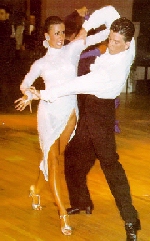
Paso Doble originates from Spain. It developed on the basis of movements performed by the matadors during the bull fights. In Paso Doble the man (matador) is in focus more than in any other dance. The lady is left with playing a role of a cape ("cappa") the red canvas of the torreador or a bull, depending on circumstances. The dance came into fashion around 1920. It is probably the last dance you will learn if you take up Latin American dance classes. That's because it is based around previously agreed choreography (arranged precisely to the music) and it is far more difficult to lead and improvise it. Syllabus: |